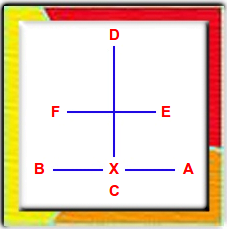Pattern Definition & Diagram

(39 Movements). KWANG-GAE is named after the famous Kwang-Gae-Toh-Wang, the 19th King of the Koguryo Dynasty, who regained all the lost territories including the greater part of Manchuria. The diagram represents the expansion and recovery of lost territory. The 39 movements refer to the first two figures of 391 A. D, the year he came to the throne.
Click the “next” and “previous” arrows on the image below to step through this pattern.
[wowslider id=”15″]
Pattern Videos
Saju Jirugi, Saju Magki and Chon-Ji.
Rare International Tae Kwon-Do (ITF) video produced by General Choi.
You can see Grand Master Park Jung Tae, Grand Master Choi Jung Wha and other masters of the ITF performing tuls and explaining the movements of each Tul.
Kwang-Gae Tul performed by Jaroslaw Suska (5th Degree)
The history of Kwang-Gae
The Life of Kwang-Gae
 King Kwang-Gae-Toh-Wang (meaning “broad expander of territory”) was born in 374 AD and ascended to the throne in 391, at the age of just seventeen, to become the 19th king of the Koguryo Dynasty. He ruled over Koguryo at the time in Korea’s history known as The Three Kingdoms, so called because during this time the Korean peninsula was constantly being fought over by the three Koguryo, Silla and Paekche dynasties. He is sometimes referred to as Great King Yeongnak, after the era name selected by him.
King Kwang-Gae-Toh-Wang (meaning “broad expander of territory”) was born in 374 AD and ascended to the throne in 391, at the age of just seventeen, to become the 19th king of the Koguryo Dynasty. He ruled over Koguryo at the time in Korea’s history known as The Three Kingdoms, so called because during this time the Korean peninsula was constantly being fought over by the three Koguryo, Silla and Paekche dynasties. He is sometimes referred to as Great King Yeongnak, after the era name selected by him.
He expanded Koguryo’s territories far into the Korean peninsula by advancing southward at the expense of the Paekche dynasty to occupy the north of the Han River, and occupied Manchurian territory to the east of Liaohe. On his death in 413, at just 39 years of age, Koguryo ruled everything between the Sungari and Han Rivers. This gave it control over two thirds of what is now modern Korea as well as a large part of Manchuria. In addition, the chieftains of Silla submitted to the northern kingdom’s authority in 399 to receive protection from Japanese raids. Only Paekche continued to resist Koguryo domination during this period, thereby preventing what would have been the first recognised unification of the Korean peninsula. During his reign, King Kwang-Gae conquered 65 walled cities and some 1,400 villages, in addition to aiding Silla when it was attacked by the Japanese. In 392 he built nine Buddhist temples in Pyongyang. His accomplishments are recorded on a monument which was erected in 414 in southern Manchuria. The first movement in Kwang Gae Tul is stated as :
Bring the left foot to the right foot, forming a close ready stance B toward D, bringing both hands in a circular motion. Some speculate that it might signify the expansion and recovery of lost territory as per the pattern meaning. An interesting story about this movement. It is said to signify the warrior-king standing amidst his army on either side of him, facing an enemy. Surveying the weather conditions, position of the sun etc to determine if they are favourable to his army. He then breaks his hands/arms apart in a circular motion signaling his army to attack from those flanks.
The South Korean Navy has a frigate: The 3,900 ton King Kwang-Gae-to-dae-wang was commissioned last year, and is the first of the KDX-1 class FFGs. It is fitted with 8 Block 1C Harpoons, and RIM-7P Sea Sparrow in Mk 48 VLS. Around the end of 3rd century BC in China, Chin got perished and Han arose. In the chaos during the change, a man Wui-Man, with a group of his people, came over to King Jun, who let him defend the western border of Ko-Cho-Sun. However, Wui-Man later subverted King Jun and made himself a King. King Wu-Guo, a grandson of Wui-Man, cut off direct trade between Han and other countries on the outskirts of Ko-Cho-Sun and made big geographical advantages by transit trade between the two. Han got upset for this and attacked Ko-Cho-Sun. After one year lasted war, Ko- Cho-Sun got perished by Han. However, King Mi-Chun and Kwang-Gae-To, of Koguryo of the Era of Three Kingdoms recovered the lost territories.


